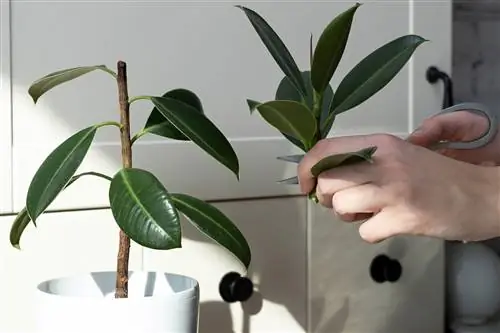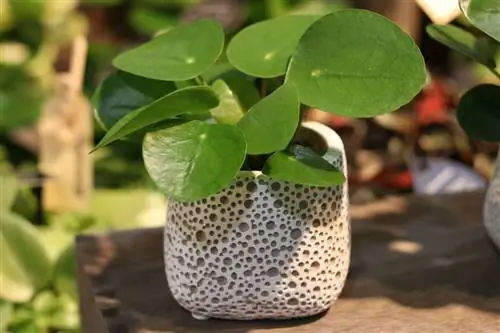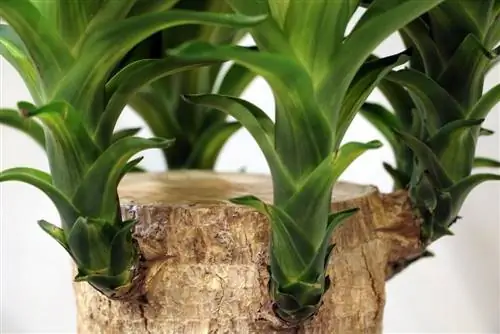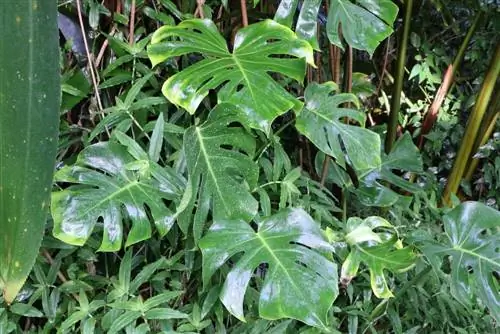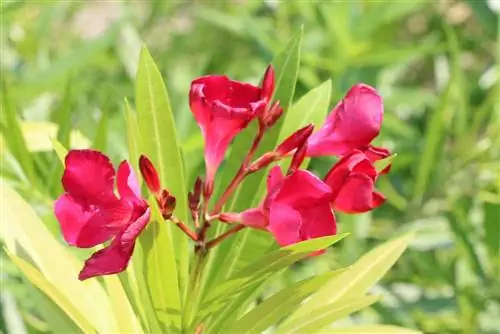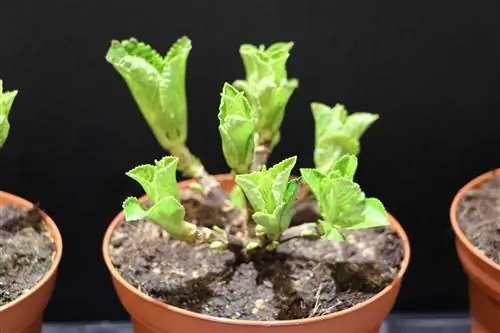- Author admin [email protected].
- Public 2023-12-17 03:39.
- Last modified 2025-01-24 12:45.
Just one rubber tree is usually not enough for lovers of this decorative plant. But the houseplant, which belongs to the genus Ficus Elastica, is easy to propagate. If the tree has become too large for the apartment and has grown too high, it must be cut back; this cut can be used as a cutting for a new tree. But even if no pruning is to be carried out, individual new shoots can be used in spring to propagate the popular, evergreen plant.
Winning offshoots
If you want to propagate your rubber tree, you usually take cuttings that you have previously separated from the tree for one or more offshoots. This is the easiest way to grow a cutting and, if desired, to obtain many new plants of the popular Ficus Elastica. This method is simple and safe because most cuttings root and new offshoots are created. The right time to obtain the offshoots:
- in spring, when the new shoots appear
- these are broken by hand
- all year round if a mother plant has grown too large
- simply cut the trunk at the desired height
- Do not throw away the cut tip but use it as an offshoot
Tip:
Pruning the trunk does not harm the rubber tree, because new shoots quickly form below the cut points and cover them. Cover the interface with tree wound wax to allow the wound to heal.
Gain cuttings
If cuttings are to become offshoots, then you should choose nice, straight shoots so that the offshoot can grow straight from the start. The shoots on which a new leaf should already be growing can simply be removed by hand on the trunk. The sap that is secreted here should be carefully dabbed on the trunk and the bleeding area may be treated with wound wax. The milky liquid on the removed cutting should also be carefully removed with a clean, dry cloth. The newly obtained cutting is treated as follows:
- Put the shoot in a glass with water
- always make sure there is enough water
- Leaves should not come into contact with the water
- Ideally place in a warm and bright location
- no direct sunlight,
- otherwise the leaf on this could burn
- rooting can take up to three months, sometimes even longer
- there may be a week-long standstill in the meantime
- If the leaves on the shoot are green and juicy, the shoot is alive
Tip:
A cutting can also be planted immediately in soil without roots, but then it must always be kept well wet. But rooting is not always successful in this way and the offshoots wither. To promote rooting in the soil, it is increasingly recommended to add cinnamon powder to the stump before placing the cutting in the soil. However, whether this makes sense has not yet been researched.
Winning offshoots with trunk
If the mother tree has become too large, it must be cut. This is the right time to attract a new offshoot that has also already reached a certain height. Rubber trees can reach a height of four meters. If they are prevented from growing in height by the ceiling in the apartment, they will simply continue to grow crooked at the top. To prevent this, the trunk of the rubber tree can be shortened to the desired height. However, it should also be noted that new shoots appear around the interface, which also grow quickly. Therefore, the interface should be chosen at a height at which the rubber tree can be given the opportunity to grow upwards again for a few years. With the remaining, removed trunk, proceed as follows:
- Depending on how long the cut tip is, it can be divided again
- this is how several offshoots can be obtained
- these are placed in a glass, or depending on the size, in a vase with water
- Avoid contact with water if leaves are present
- warm and bright
- The roots will form after about three months
- If these are large enough, they can be planted
Tip:
If the trunk is cut, only sharp, well-cutting secateurs that have been previously disinfected with pure alcohol should be used. If the cut is not smooth but frayed, this can damage the rubber tree. If pruning shears are not disinfected before cutting, bacteria can adhere to them, which could possibly get to and into the cut and damage the plant.
Plants
If strong roots have formed on the cutting after three months, then the cutting can be planted. It makes sense if a glass or a transparent vase was used for rooting, because then the appropriate time can be seen from the outside when the offshoots can be placed in the ground. When planting, the following should therefore be taken into account:
- when the roots are approx. 2-3 cm long, you can plant
- Use just a small pot for the small offshoot
- create a drainage over the drain hole
- use pebbles for this
- plant fleece is placed over it
- Put half of the soil in the pot
- Insert cuttings very carefully so that the fragile roots are not damaged
- Carefully fill in the remaining soil, press lightly
Tip:
Especially the new, small offshoots are still quite vulnerable, so they should be checked regularly for spider mites or thrisps and other pests, especially if they are offered an outdoor location.
Substrate & Soil
Normal potting soil for houseplants is also suitable for the new offshoot of the Ficus elastica. This is usually filled with compost and initially contains enough fertilizer to ensure the growth of the new plants. Alternatively, garden soil with a peat-sand mixture can also be used here. However, the soil should not be too firm so that the small roots have the opportunity to spread and grow. If the soil is too firm and heavy, the offshoot may not develop further and will wither away because the roots will be literally crushed by the soil.
Watering and fertilizing
If the cuttings were placed in fresh potting soil, then fertilizing is not necessary for the time being, because the fresh soil has enough nutrients to get started. However, after about three months, the new rubber tree can be regularly supplied with a fertilizer for green houseplants. When adding fertilizer, you must always pay attention to the manufacturer's instructions, because every form of fertilizer, for example liquid fertilizer or granular long-term fertilizer, behaves differently. When watering, the following should also be taken into account:
- the offshoot needs a lot of water at the beginning
- therefore watering should be done regularly
- the soil should always be kept slightly moist
- How to accelerate root growth
- Waterlogging should definitely be avoided
- so pour excess water out of the plate half an hour after watering
Location
The rubber tree needs a lot of light and brightness to thrive. If the cuttings were taken in spring, this is a good time because the days are longer and there is more natural light. When the days get warmer, the cuttings in the water-filled vases or jars can also be taken outside to a bright but protected place. However, night frost should definitely be avoided. But as a rule, the small containers in which the cuttings are located are quickly put outside in the morning and back inside in the protected area in the evening. However, direct sunlight should be avoided. If the offshoots have been planted after rooting, the same conditions apply to the ideal location. This should therefore look like this:
- bright and warm
- on warm days in spring on the balcony or terrace
- choose a protected spot here
- do not place in direct sun
- if winding up in the room, choose the brightest place in the apartment
- a windowsill without direct sunlight is ideal here
Tip:
The growing rubber tree should be rotated more often. So it doesn't grow one-sided towards the light but develops a straight trunk.
Conclusion
If you already have a rubber tree, you can grow many new small plants from it using offshoots. It is very easy and possible even for inexperienced hobby gardeners and plant lovers to obtain cuttings. However, a little patience is required here, as rooting can take up to three months or more. After this time, most offshoots form roots and later develop into a magnificent tree if the few care instructions are followed.

